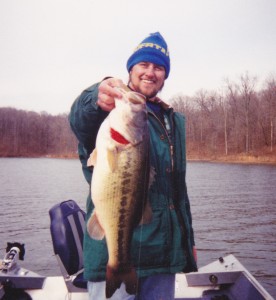Ray was a stocky gray-haired man in his late 50s. We chatted for only a few minutes that day, but we spent hours on the phone and then in the boat, even in winter. If Ray could find water above 40 degrees, he could catch bass. He proved it the first time he took me out to Cedar Lake. I met him at the ramp as he was launching his aluminum boat with a 9.9 horsepower Yamaha.
He was the guide for the day, and I was his eager student. The sky was overcast, but 42-degree water with warm nighttime temperatures made it different from most days in February.
“Night-time temperature is more important than day-time temperature,” Ray explained as we motored slowly to our spot. “Fishermen always look at day-time temperature and miss it because they fail to pay attention to night trends and how that affects the water overall. It takes at least two to three days for a water temperature change to positively improve the fishing this time of year.”
He explained his approach to catching winter bass with his favorite soft jerk bait, a Mann’s Shadow. While other bass fishermen fished a jig too quickly on the bottom, he was able to catch the winter suspended bass. We pulled up to his first deadfall tree, and he demonstrated his stealthy approach using spinning tackle and a slow, slow, slow retrieve. I had to follow his lead and make corrections as he pointed them out to me.
His Shadow was probably in 10 feet of water in front of the submerged tree when he reeled down the slack and set the hook on a three-pound bass. He fought it firmly and set his foot down on the trolling motor to motor farther away from the tree. A bass can easily break off eight-pound-test line on a tree limb.
He lipped the fish himself and held it up for me to see before releasing it.
He demonstrated the same technique again and caught another about five minutes later 10 yards farther up. I was mimicking his every move and was worried that I would not be able to duplicate his pattern. We came to the point following those two deadfalls, and I took the first cast to the shoreline.
We both saw a big swirl, and I could not believe a big bass would be that shallow in February. I reeled in the slack and set the hook firmly but with restraint. The resistance was as solid as it could be without breaking the line. The drag had been set perfectly.
Ray motored away from the point, and I held on with my rod tip high in the air. The weight was too heavy to reel with Ray steering us to deeper water.
Out in deeper water, I went to loosen the drag, and he stopped me.
“That should be right. Keep the pressure on and start reeling when you can.”
I did slowly and was amazed by this fish’s strength. After a few minutes, the fish was at the side of the boat, and Ray netted her in one fast swoop.
I laughed, astounded as he held the net and unhooked the fish. I said, “That has to be nine pounds or more!”
“No, it’s eight two, maybe three.”
I held it while he found the scale. He weighed it. Sure enough, eight pounds, three ounces.
Needless to say, after only a few hours on the water with Ray, he became my mentor. Much of what I learned about fisheries science started with conversations with him.
Copyright 2012 Jason Covington
U.S. Library of Congress

